Effects of TNF-α Blockade in Glomerulonephritis
VerifiedAdded on 2020/03/04
|8
|1691
|415
AI Summary
This assignment investigates the therapeutic potential of blocking tumor necrosis factor-alpha (TNF-α) in a mouse model of crescentic glomerulonephritis. Through four experiments, it demonstrates that TNF-α blockade significantly reduces glomerular inflammation, crescent formation, tubulointerstitial scarring, and markers of fibrosis. The treatment also preserves renal function as measured by serum creatinine levels. Importantly, the benefits of TNF-α blockade were observed even when treatment was initiated after the onset of maximum glomerular inflammation, suggesting its potential as a therapeutic strategy for managing this kidney disease.
Contribute Materials
Your contribution can guide someone’s learning journey. Share your
documents today.
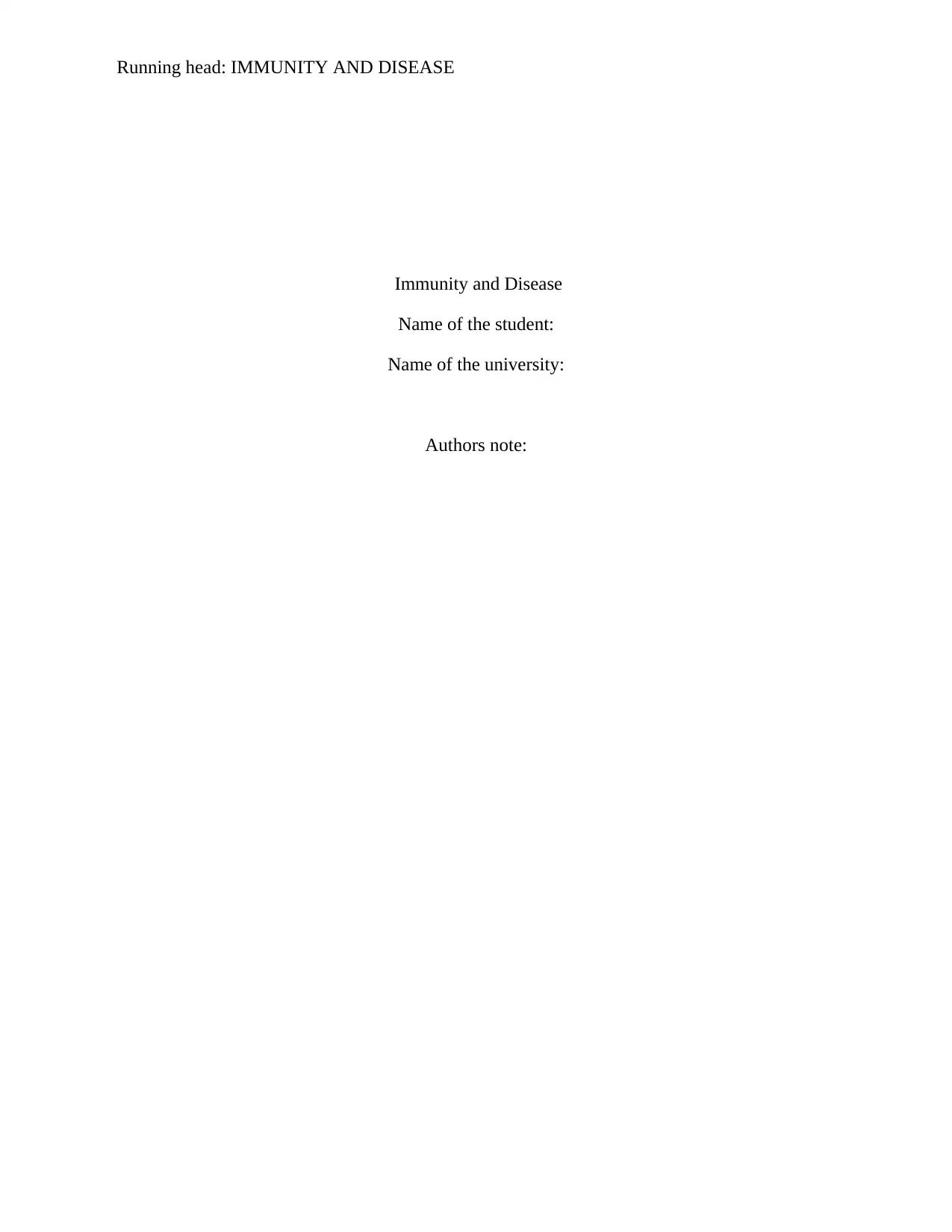
Running head: IMMUNITY AND DISEASE
Immunity and Disease
Name of the student:
Name of the university:
Authors note:
Immunity and Disease
Name of the student:
Name of the university:
Authors note:
Secure Best Marks with AI Grader
Need help grading? Try our AI Grader for instant feedback on your assignments.
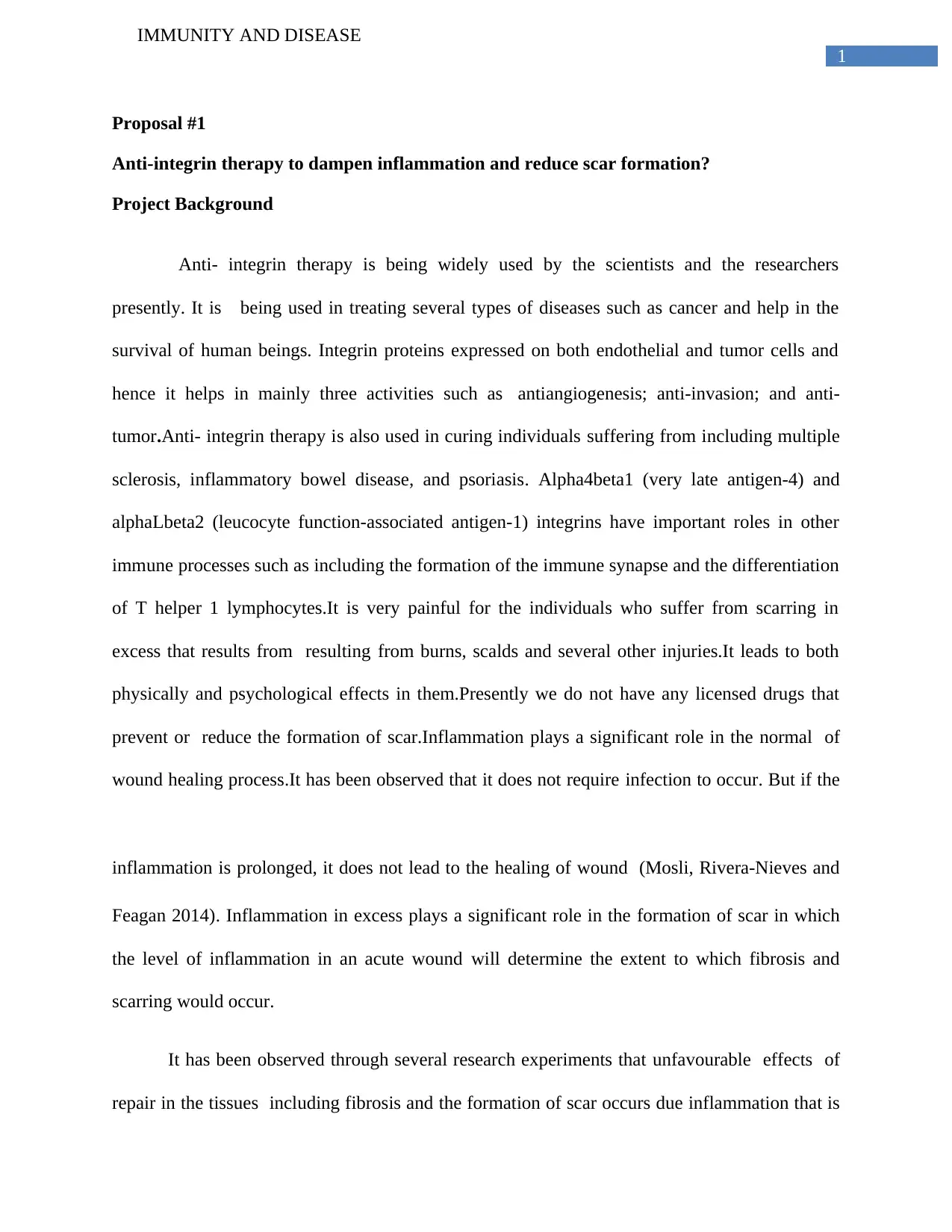
1
IMMUNITY AND DISEASE
Proposal #1
Anti-integrin therapy to dampen inflammation and reduce scar formation?
Project Background
Anti- integrin therapy is being widely used by the scientists and the researchers
presently. It is being used in treating several types of diseases such as cancer and help in the
survival of human beings. Integrin proteins expressed on both endothelial and tumor cells and
hence it helps in mainly three activities such as antiangiogenesis; anti-invasion; and anti-
tumor.Anti- integrin therapy is also used in curing individuals suffering from including multiple
sclerosis, inflammatory bowel disease, and psoriasis. Alpha4beta1 (very late antigen-4) and
alphaLbeta2 (leucocyte function-associated antigen-1) integrins have important roles in other
immune processes such as including the formation of the immune synapse and the differentiation
of T helper 1 lymphocytes.It is very painful for the individuals who suffer from scarring in
excess that results from resulting from burns, scalds and several other injuries.It leads to both
physically and psychological effects in them.Presently we do not have any licensed drugs that
prevent or reduce the formation of scar.Inflammation plays a significant role in the normal of
wound healing process.It has been observed that it does not require infection to occur. But if the
inflammation is prolonged, it does not lead to the healing of wound (Mosli, Rivera-Nieves and
Feagan 2014). Inflammation in excess plays a significant role in the formation of scar in which
the level of inflammation in an acute wound will determine the extent to which fibrosis and
scarring would occur.
It has been observed through several research experiments that unfavourable effects of
repair in the tissues including fibrosis and the formation of scar occurs due inflammation that is
IMMUNITY AND DISEASE
Proposal #1
Anti-integrin therapy to dampen inflammation and reduce scar formation?
Project Background
Anti- integrin therapy is being widely used by the scientists and the researchers
presently. It is being used in treating several types of diseases such as cancer and help in the
survival of human beings. Integrin proteins expressed on both endothelial and tumor cells and
hence it helps in mainly three activities such as antiangiogenesis; anti-invasion; and anti-
tumor.Anti- integrin therapy is also used in curing individuals suffering from including multiple
sclerosis, inflammatory bowel disease, and psoriasis. Alpha4beta1 (very late antigen-4) and
alphaLbeta2 (leucocyte function-associated antigen-1) integrins have important roles in other
immune processes such as including the formation of the immune synapse and the differentiation
of T helper 1 lymphocytes.It is very painful for the individuals who suffer from scarring in
excess that results from resulting from burns, scalds and several other injuries.It leads to both
physically and psychological effects in them.Presently we do not have any licensed drugs that
prevent or reduce the formation of scar.Inflammation plays a significant role in the normal of
wound healing process.It has been observed that it does not require infection to occur. But if the
inflammation is prolonged, it does not lead to the healing of wound (Mosli, Rivera-Nieves and
Feagan 2014). Inflammation in excess plays a significant role in the formation of scar in which
the level of inflammation in an acute wound will determine the extent to which fibrosis and
scarring would occur.
It has been observed through several research experiments that unfavourable effects of
repair in the tissues including fibrosis and the formation of scar occurs due inflammation that is
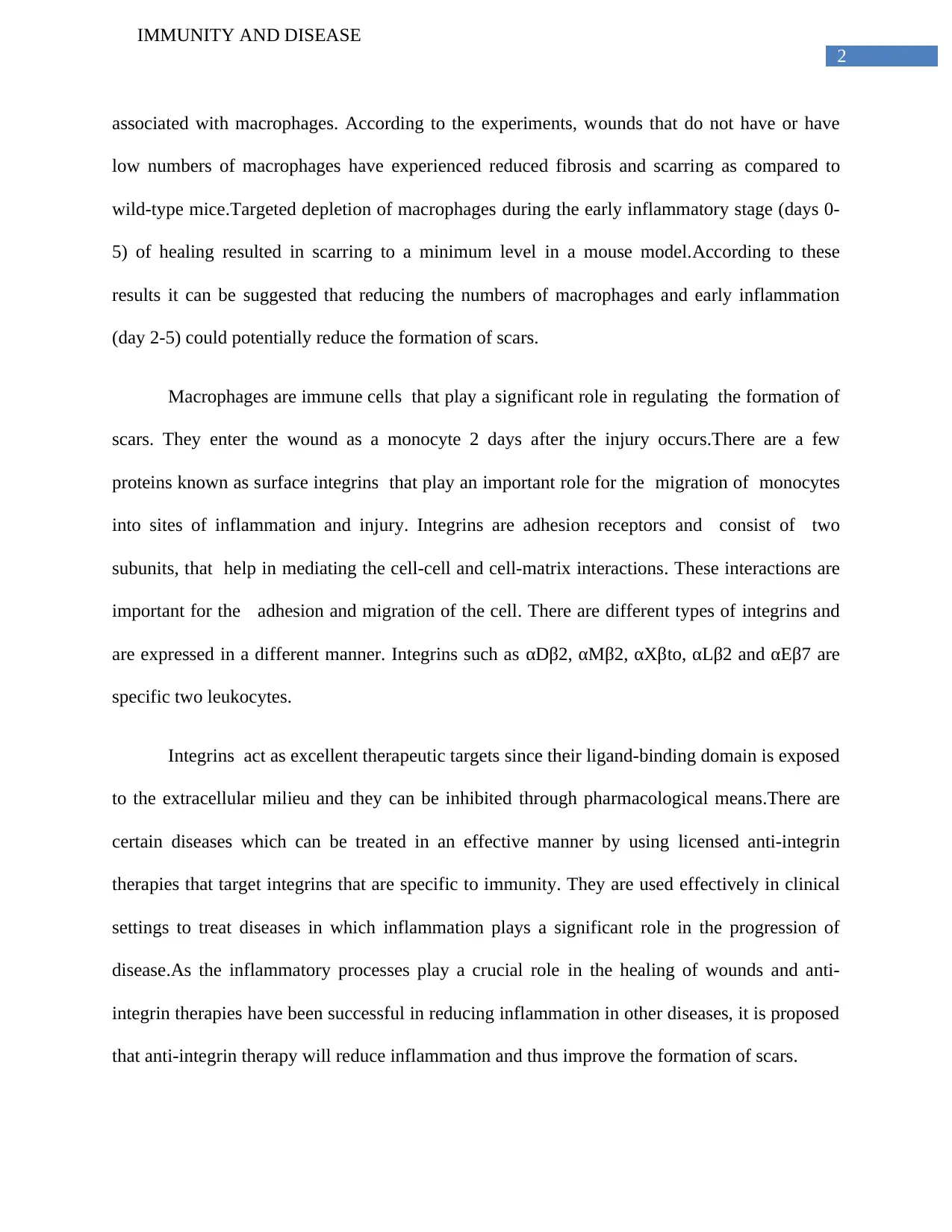
2
IMMUNITY AND DISEASE
associated with macrophages. According to the experiments, wounds that do not have or have
low numbers of macrophages have experienced reduced fibrosis and scarring as compared to
wild-type mice.Targeted depletion of macrophages during the early inflammatory stage (days 0-
5) of healing resulted in scarring to a minimum level in a mouse model.According to these
results it can be suggested that reducing the numbers of macrophages and early inflammation
(day 2-5) could potentially reduce the formation of scars.
Macrophages are immune cells that play a significant role in regulating the formation of
scars. They enter the wound as a monocyte 2 days after the injury occurs.There are a few
proteins known as surface integrins that play an important role for the migration of monocytes
into sites of inflammation and injury. Integrins are adhesion receptors and consist of two
subunits, that help in mediating the cell-cell and cell-matrix interactions. These interactions are
important for the adhesion and migration of the cell. There are different types of integrins and
are expressed in a different manner. Integrins such as αDβ2, αMβ2, αXβto, αLβ2 and αEβ7 are
specific two leukocytes.
Integrins act as excellent therapeutic targets since their ligand-binding domain is exposed
to the extracellular milieu and they can be inhibited through pharmacological means.There are
certain diseases which can be treated in an effective manner by using licensed anti-integrin
therapies that target integrins that are specific to immunity. They are used effectively in clinical
settings to treat diseases in which inflammation plays a significant role in the progression of
disease.As the inflammatory processes play a crucial role in the healing of wounds and anti-
integrin therapies have been successful in reducing inflammation in other diseases, it is proposed
that anti-integrin therapy will reduce inflammation and thus improve the formation of scars.
IMMUNITY AND DISEASE
associated with macrophages. According to the experiments, wounds that do not have or have
low numbers of macrophages have experienced reduced fibrosis and scarring as compared to
wild-type mice.Targeted depletion of macrophages during the early inflammatory stage (days 0-
5) of healing resulted in scarring to a minimum level in a mouse model.According to these
results it can be suggested that reducing the numbers of macrophages and early inflammation
(day 2-5) could potentially reduce the formation of scars.
Macrophages are immune cells that play a significant role in regulating the formation of
scars. They enter the wound as a monocyte 2 days after the injury occurs.There are a few
proteins known as surface integrins that play an important role for the migration of monocytes
into sites of inflammation and injury. Integrins are adhesion receptors and consist of two
subunits, that help in mediating the cell-cell and cell-matrix interactions. These interactions are
important for the adhesion and migration of the cell. There are different types of integrins and
are expressed in a different manner. Integrins such as αDβ2, αMβ2, αXβto, αLβ2 and αEβ7 are
specific two leukocytes.
Integrins act as excellent therapeutic targets since their ligand-binding domain is exposed
to the extracellular milieu and they can be inhibited through pharmacological means.There are
certain diseases which can be treated in an effective manner by using licensed anti-integrin
therapies that target integrins that are specific to immunity. They are used effectively in clinical
settings to treat diseases in which inflammation plays a significant role in the progression of
disease.As the inflammatory processes play a crucial role in the healing of wounds and anti-
integrin therapies have been successful in reducing inflammation in other diseases, it is proposed
that anti-integrin therapy will reduce inflammation and thus improve the formation of scars.
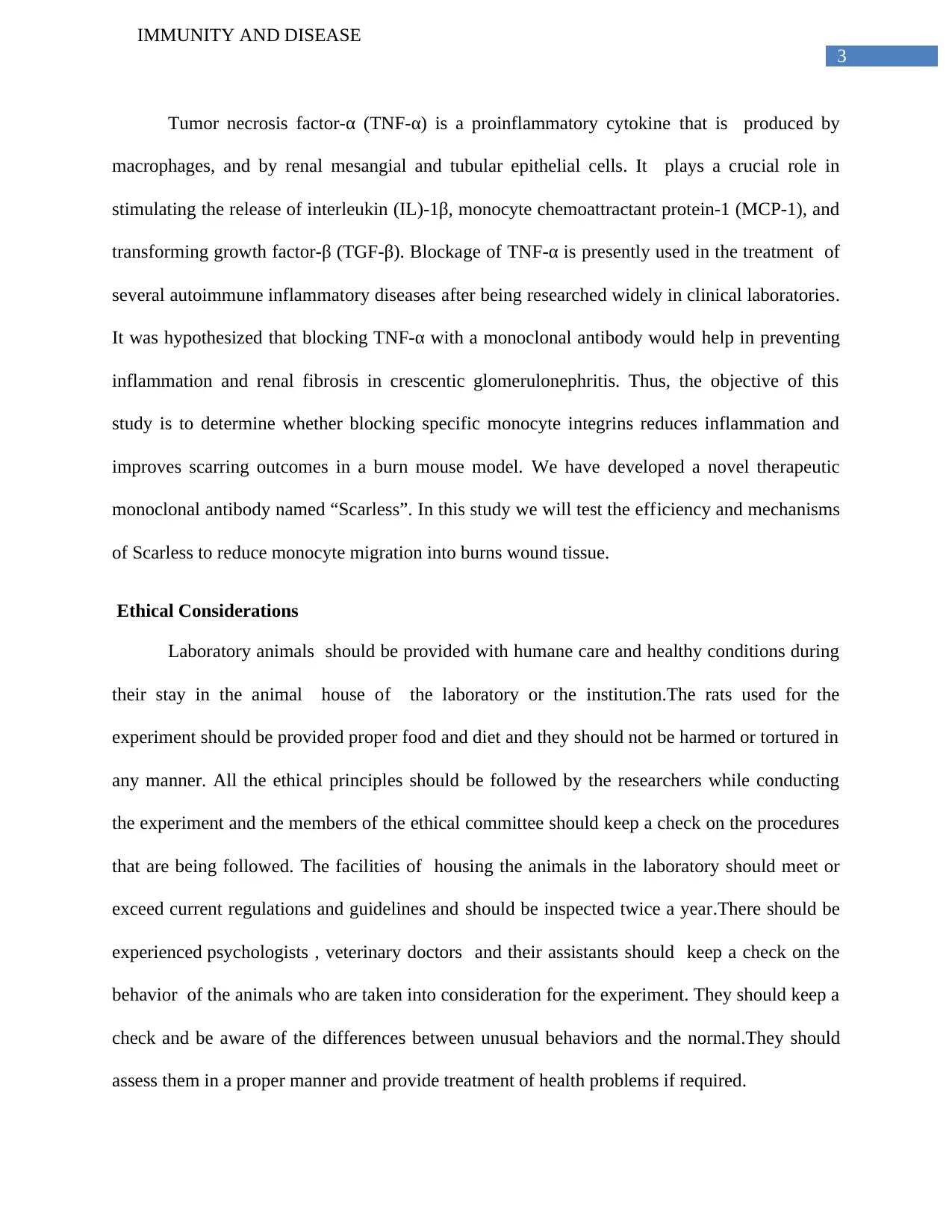
3
IMMUNITY AND DISEASE
Tumor necrosis factor-α (TNF-α) is a proinflammatory cytokine that is produced by
macrophages, and by renal mesangial and tubular epithelial cells. It plays a crucial role in
stimulating the release of interleukin (IL)-1β, monocyte chemoattractant protein-1 (MCP-1), and
transforming growth factor-β (TGF-β). Blockage of TNF-α is presently used in the treatment of
several autoimmune inflammatory diseases after being researched widely in clinical laboratories.
It was hypothesized that blocking TNF-α with a monoclonal antibody would help in preventing
inflammation and renal fibrosis in crescentic glomerulonephritis. Thus, the objective of this
study is to determine whether blocking specific monocyte integrins reduces inflammation and
improves scarring outcomes in a burn mouse model. We have developed a novel therapeutic
monoclonal antibody named “Scarless”. In this study we will test the efficiency and mechanisms
of Scarless to reduce monocyte migration into burns wound tissue.
Ethical Considerations
Laboratory animals should be provided with humane care and healthy conditions during
their stay in the animal house of the laboratory or the institution.The rats used for the
experiment should be provided proper food and diet and they should not be harmed or tortured in
any manner. All the ethical principles should be followed by the researchers while conducting
the experiment and the members of the ethical committee should keep a check on the procedures
that are being followed. The facilities of housing the animals in the laboratory should meet or
exceed current regulations and guidelines and should be inspected twice a year.There should be
experienced psychologists , veterinary doctors and their assistants should keep a check on the
behavior of the animals who are taken into consideration for the experiment. They should keep a
check and be aware of the differences between unusual behaviors and the normal.They should
assess them in a proper manner and provide treatment of health problems if required.
IMMUNITY AND DISEASE
Tumor necrosis factor-α (TNF-α) is a proinflammatory cytokine that is produced by
macrophages, and by renal mesangial and tubular epithelial cells. It plays a crucial role in
stimulating the release of interleukin (IL)-1β, monocyte chemoattractant protein-1 (MCP-1), and
transforming growth factor-β (TGF-β). Blockage of TNF-α is presently used in the treatment of
several autoimmune inflammatory diseases after being researched widely in clinical laboratories.
It was hypothesized that blocking TNF-α with a monoclonal antibody would help in preventing
inflammation and renal fibrosis in crescentic glomerulonephritis. Thus, the objective of this
study is to determine whether blocking specific monocyte integrins reduces inflammation and
improves scarring outcomes in a burn mouse model. We have developed a novel therapeutic
monoclonal antibody named “Scarless”. In this study we will test the efficiency and mechanisms
of Scarless to reduce monocyte migration into burns wound tissue.
Ethical Considerations
Laboratory animals should be provided with humane care and healthy conditions during
their stay in the animal house of the laboratory or the institution.The rats used for the
experiment should be provided proper food and diet and they should not be harmed or tortured in
any manner. All the ethical principles should be followed by the researchers while conducting
the experiment and the members of the ethical committee should keep a check on the procedures
that are being followed. The facilities of housing the animals in the laboratory should meet or
exceed current regulations and guidelines and should be inspected twice a year.There should be
experienced psychologists , veterinary doctors and their assistants should keep a check on the
behavior of the animals who are taken into consideration for the experiment. They should keep a
check and be aware of the differences between unusual behaviors and the normal.They should
assess them in a proper manner and provide treatment of health problems if required.
Secure Best Marks with AI Grader
Need help grading? Try our AI Grader for instant feedback on your assignments.
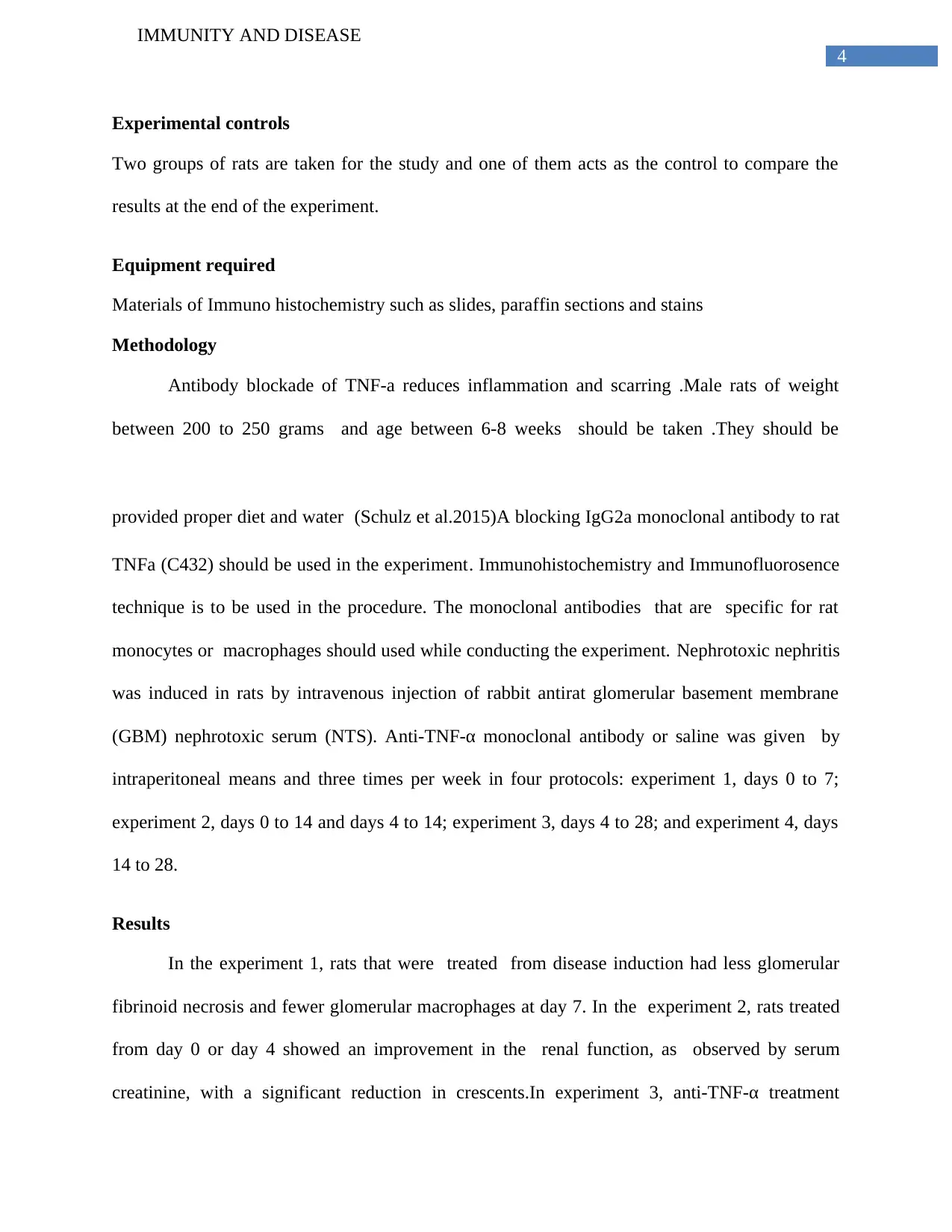
4
IMMUNITY AND DISEASE
Experimental controls
Two groups of rats are taken for the study and one of them acts as the control to compare the
results at the end of the experiment.
Equipment required
Materials of Immuno histochemistry such as slides, paraffin sections and stains
Methodology
Antibody blockade of TNF-a reduces inflammation and scarring .Male rats of weight
between 200 to 250 grams and age between 6-8 weeks should be taken .They should be
provided proper diet and water (Schulz et al.2015)A blocking IgG2a monoclonal antibody to rat
TNFa (C432) should be used in the experiment. Immunohistochemistry and Immunofluorosence
technique is to be used in the procedure. The monoclonal antibodies that are specific for rat
monocytes or macrophages should used while conducting the experiment. Nephrotoxic nephritis
was induced in rats by intravenous injection of rabbit antirat glomerular basement membrane
(GBM) nephrotoxic serum (NTS). Anti-TNF-α monoclonal antibody or saline was given by
intraperitoneal means and three times per week in four protocols: experiment 1, days 0 to 7;
experiment 2, days 0 to 14 and days 4 to 14; experiment 3, days 4 to 28; and experiment 4, days
14 to 28.
Results
In the experiment 1, rats that were treated from disease induction had less glomerular
fibrinoid necrosis and fewer glomerular macrophages at day 7. In the experiment 2, rats treated
from day 0 or day 4 showed an improvement in the renal function, as observed by serum
creatinine, with a significant reduction in crescents.In experiment 3, anti-TNF-α treatment
IMMUNITY AND DISEASE
Experimental controls
Two groups of rats are taken for the study and one of them acts as the control to compare the
results at the end of the experiment.
Equipment required
Materials of Immuno histochemistry such as slides, paraffin sections and stains
Methodology
Antibody blockade of TNF-a reduces inflammation and scarring .Male rats of weight
between 200 to 250 grams and age between 6-8 weeks should be taken .They should be
provided proper diet and water (Schulz et al.2015)A blocking IgG2a monoclonal antibody to rat
TNFa (C432) should be used in the experiment. Immunohistochemistry and Immunofluorosence
technique is to be used in the procedure. The monoclonal antibodies that are specific for rat
monocytes or macrophages should used while conducting the experiment. Nephrotoxic nephritis
was induced in rats by intravenous injection of rabbit antirat glomerular basement membrane
(GBM) nephrotoxic serum (NTS). Anti-TNF-α monoclonal antibody or saline was given by
intraperitoneal means and three times per week in four protocols: experiment 1, days 0 to 7;
experiment 2, days 0 to 14 and days 4 to 14; experiment 3, days 4 to 28; and experiment 4, days
14 to 28.
Results
In the experiment 1, rats that were treated from disease induction had less glomerular
fibrinoid necrosis and fewer glomerular macrophages at day 7. In the experiment 2, rats treated
from day 0 or day 4 showed an improvement in the renal function, as observed by serum
creatinine, with a significant reduction in crescents.In experiment 3, anti-TNF-α treatment
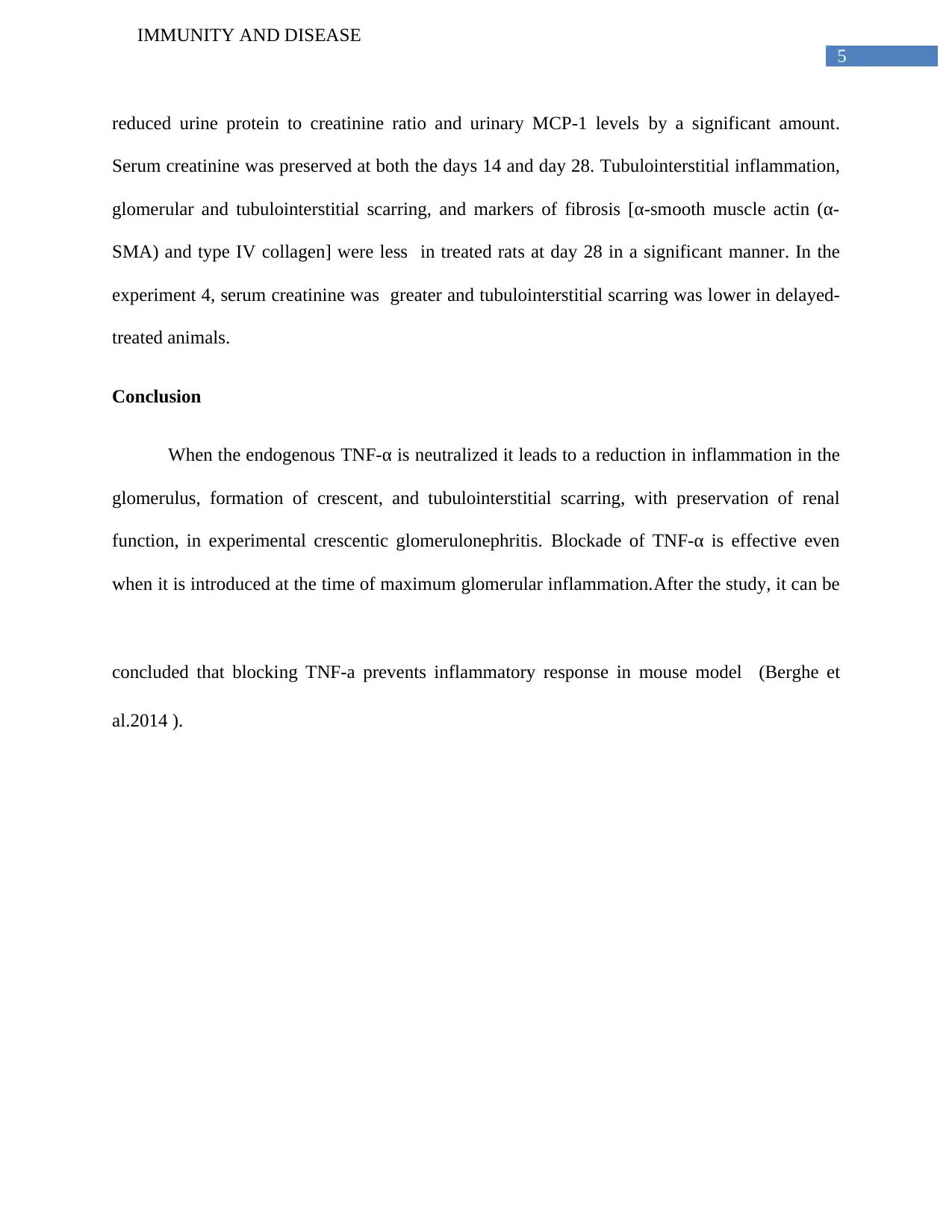
5
IMMUNITY AND DISEASE
reduced urine protein to creatinine ratio and urinary MCP-1 levels by a significant amount.
Serum creatinine was preserved at both the days 14 and day 28. Tubulointerstitial inflammation,
glomerular and tubulointerstitial scarring, and markers of fibrosis [α-smooth muscle actin (α-
SMA) and type IV collagen] were less in treated rats at day 28 in a significant manner. In the
experiment 4, serum creatinine was greater and tubulointerstitial scarring was lower in delayed-
treated animals.
Conclusion
When the endogenous TNF-α is neutralized it leads to a reduction in inflammation in the
glomerulus, formation of crescent, and tubulointerstitial scarring, with preservation of renal
function, in experimental crescentic glomerulonephritis. Blockade of TNF-α is effective even
when it is introduced at the time of maximum glomerular inflammation.After the study, it can be
concluded that blocking TNF-a prevents inflammatory response in mouse model (Berghe et
al.2014 ).
IMMUNITY AND DISEASE
reduced urine protein to creatinine ratio and urinary MCP-1 levels by a significant amount.
Serum creatinine was preserved at both the days 14 and day 28. Tubulointerstitial inflammation,
glomerular and tubulointerstitial scarring, and markers of fibrosis [α-smooth muscle actin (α-
SMA) and type IV collagen] were less in treated rats at day 28 in a significant manner. In the
experiment 4, serum creatinine was greater and tubulointerstitial scarring was lower in delayed-
treated animals.
Conclusion
When the endogenous TNF-α is neutralized it leads to a reduction in inflammation in the
glomerulus, formation of crescent, and tubulointerstitial scarring, with preservation of renal
function, in experimental crescentic glomerulonephritis. Blockade of TNF-α is effective even
when it is introduced at the time of maximum glomerular inflammation.After the study, it can be
concluded that blocking TNF-a prevents inflammatory response in mouse model (Berghe et
al.2014 ).

6
IMMUNITY AND DISEASE
IMMUNITY AND DISEASE
Paraphrase This Document
Need a fresh take? Get an instant paraphrase of this document with our AI Paraphraser
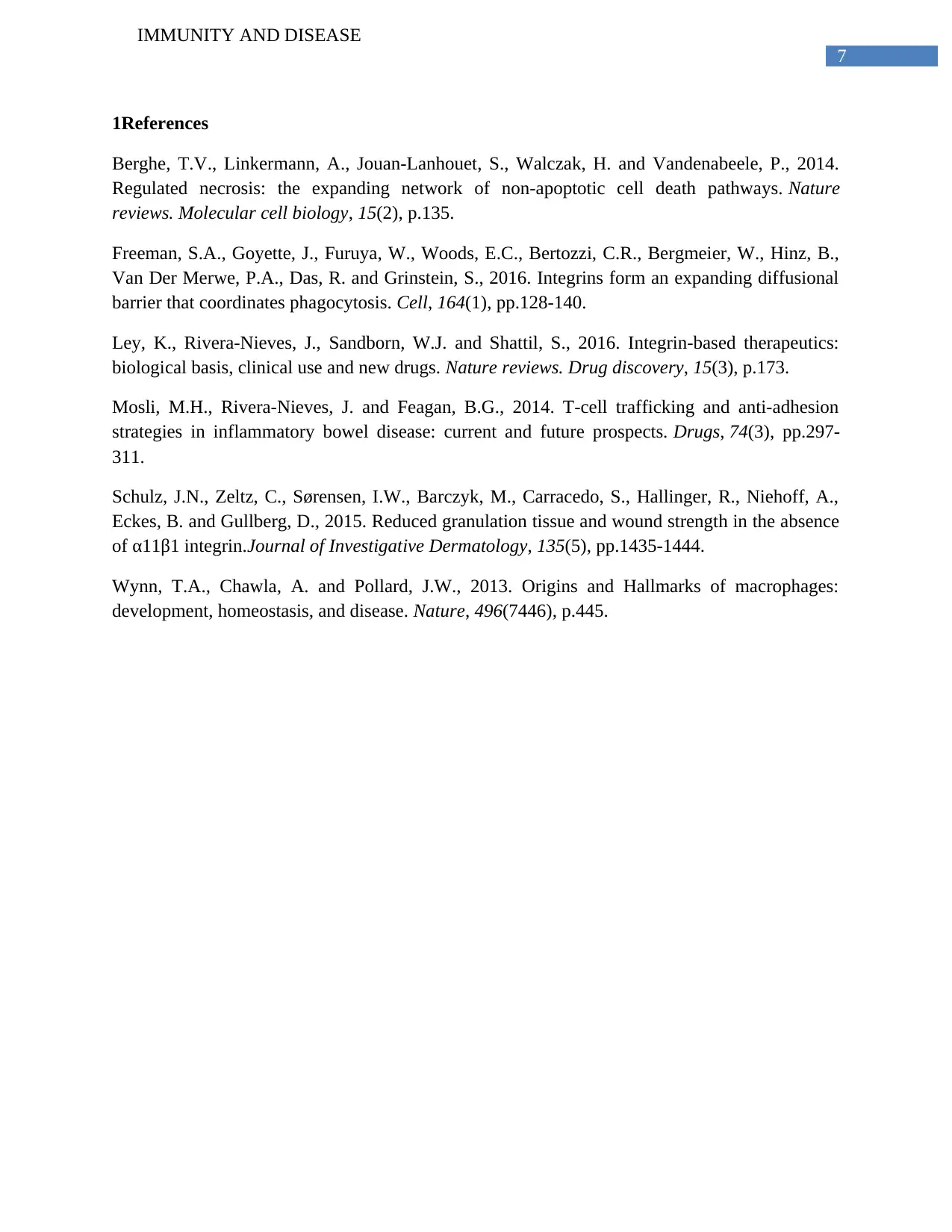
7
IMMUNITY AND DISEASE
1References
Berghe, T.V., Linkermann, A., Jouan-Lanhouet, S., Walczak, H. and Vandenabeele, P., 2014.
Regulated necrosis: the expanding network of non-apoptotic cell death pathways. Nature
reviews. Molecular cell biology, 15(2), p.135.
Freeman, S.A., Goyette, J., Furuya, W., Woods, E.C., Bertozzi, C.R., Bergmeier, W., Hinz, B.,
Van Der Merwe, P.A., Das, R. and Grinstein, S., 2016. Integrins form an expanding diffusional
barrier that coordinates phagocytosis. Cell, 164(1), pp.128-140.
Ley, K., Rivera-Nieves, J., Sandborn, W.J. and Shattil, S., 2016. Integrin-based therapeutics:
biological basis, clinical use and new drugs. Nature reviews. Drug discovery, 15(3), p.173.
Mosli, M.H., Rivera-Nieves, J. and Feagan, B.G., 2014. T-cell trafficking and anti-adhesion
strategies in inflammatory bowel disease: current and future prospects. Drugs, 74(3), pp.297-
311.
Schulz, J.N., Zeltz, C., Sørensen, I.W., Barczyk, M., Carracedo, S., Hallinger, R., Niehoff, A.,
Eckes, B. and Gullberg, D., 2015. Reduced granulation tissue and wound strength in the absence
of α11β1 integrin.Journal of Investigative Dermatology, 135(5), pp.1435-1444.
Wynn, T.A., Chawla, A. and Pollard, J.W., 2013. Origins and Hallmarks of macrophages:
development, homeostasis, and disease. Nature, 496(7446), p.445.
IMMUNITY AND DISEASE
1References
Berghe, T.V., Linkermann, A., Jouan-Lanhouet, S., Walczak, H. and Vandenabeele, P., 2014.
Regulated necrosis: the expanding network of non-apoptotic cell death pathways. Nature
reviews. Molecular cell biology, 15(2), p.135.
Freeman, S.A., Goyette, J., Furuya, W., Woods, E.C., Bertozzi, C.R., Bergmeier, W., Hinz, B.,
Van Der Merwe, P.A., Das, R. and Grinstein, S., 2016. Integrins form an expanding diffusional
barrier that coordinates phagocytosis. Cell, 164(1), pp.128-140.
Ley, K., Rivera-Nieves, J., Sandborn, W.J. and Shattil, S., 2016. Integrin-based therapeutics:
biological basis, clinical use and new drugs. Nature reviews. Drug discovery, 15(3), p.173.
Mosli, M.H., Rivera-Nieves, J. and Feagan, B.G., 2014. T-cell trafficking and anti-adhesion
strategies in inflammatory bowel disease: current and future prospects. Drugs, 74(3), pp.297-
311.
Schulz, J.N., Zeltz, C., Sørensen, I.W., Barczyk, M., Carracedo, S., Hallinger, R., Niehoff, A.,
Eckes, B. and Gullberg, D., 2015. Reduced granulation tissue and wound strength in the absence
of α11β1 integrin.Journal of Investigative Dermatology, 135(5), pp.1435-1444.
Wynn, T.A., Chawla, A. and Pollard, J.W., 2013. Origins and Hallmarks of macrophages:
development, homeostasis, and disease. Nature, 496(7446), p.445.
1 out of 8
Related Documents
Your All-in-One AI-Powered Toolkit for Academic Success.
+13062052269
info@desklib.com
Available 24*7 on WhatsApp / Email
![[object Object]](/_next/static/media/star-bottom.7253800d.svg)
Unlock your academic potential
© 2024 | Zucol Services PVT LTD | All rights reserved.





